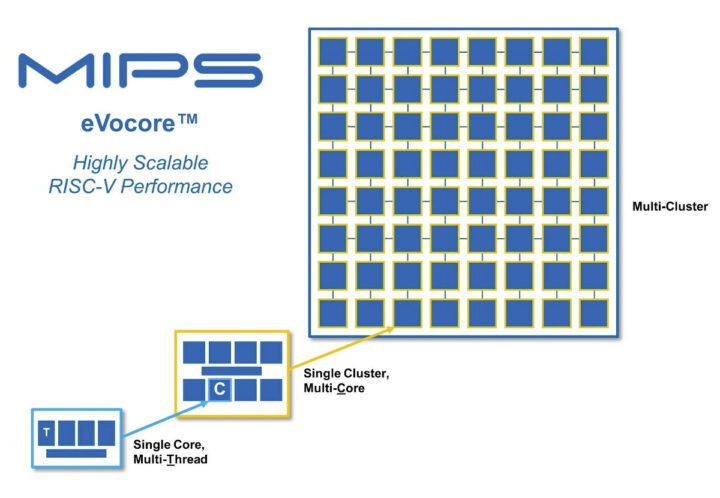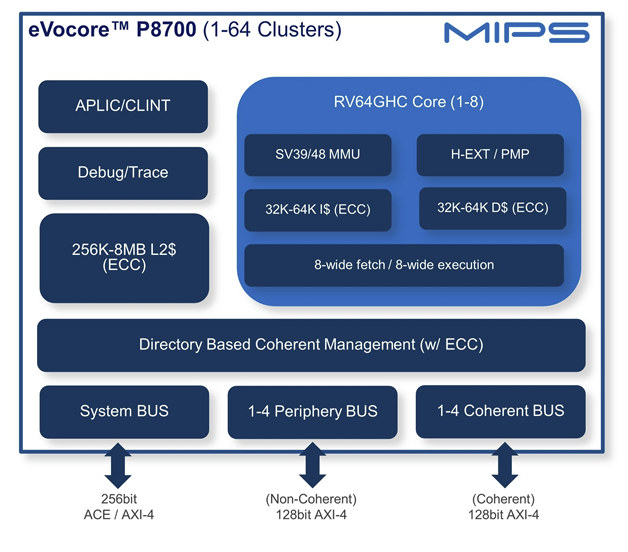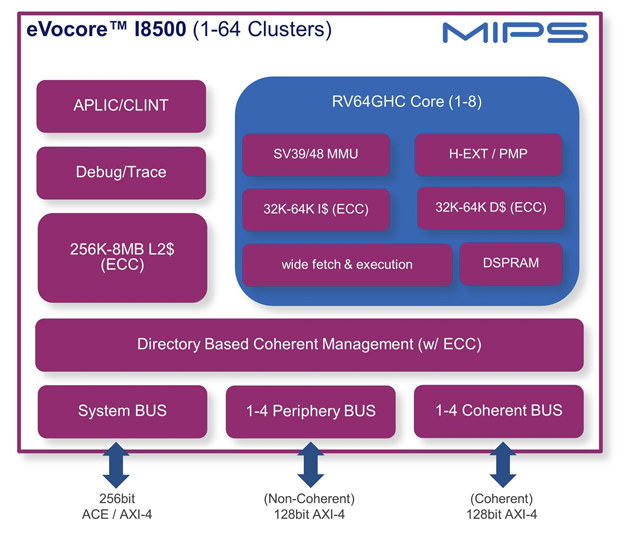MIPS is dead, right? Well, there’s now very little done on the architecture itself, MIPS (the company) has decided to switch to RISC-V architecture, and unveiled the eVocore product lineup currently comprised of the eVocore P8700 and I8500 multiprocessor IP cores.
The 64-bit cores are scalable from single-core multi-thread to a single cluster with multiple cores, and up to a multi-cluster, and target high-performance, real-time compute applications such as networking, data centers, and automotive.
The eVocore P8700 comes with a 16-stage deep pipeline with multi-issue Out-of-Order (OOO) execution and multi-threading. MIPS claims it has single-threaded performance greater than what is currently available in other RISC-V CPU IP offerings, but did not provide any numbers. It will likely be used in the cloud and high-end servers as it can scale up to 64 clusters, 512 cores and 1,024 harts/threads.
P8700 highlights:
- Multi-issue superscalar Out of Order (OOO) with Multi-threading
- 16-stage pipeline for higher clock frequency
- 8-wide instruction fetch
- 8-execution pipes: 2xALU, MDU, 2xFPU, 2xMemory
- Enhanced Coherence Manager with L2 cache
- HW pre-fetch, widened busses, reduced latency
- 48-bit physical addressing
- 256 Interrupt support, APLIC/CLINT
- System interface
- ACE or AXI: 256-bit system bus
- Optional: Coherent Bus (up to 8 ports)
- Optional: Non-coherent periphery bus (up to 4 ports)
The MIPS eVocore I8500 RISC-V core aims to achieve “best-in-class performance efficiency” with an in-order multiprocessing system for use in SoC applications. Each I8500 core combines multi-threading and an efficient triple-issue pipeline.
I8500 highlights:
- In-Order with Simultaneous Multi-threading (SMT)
- 9-stage pipeline for efficient execution
- Wide instruction fetch
- 7-execution pipes: ALU, MDU, 2xFPU, 2xMemory
- Enhanced Coherence Manager with L2 cache
- HW pre-fetch, widened busses, reduced latency
- 48-bit physical addressing
- 256 Interrupt support, APLIC/CLINT
- System interface
- ACE or AXI: 256-bit system bus
- Optional: Coherent Bus (up to 8 ports)
- Optional: Non-coherent periphery bus (up to 4 ports)
MIPS apparently plans to use RISC-V user-defined instructions (UDIs) to add extra features/accelerators, while staying fully compatible with off-the-shelf RISC-V development tools and software libraries. Other features for the eVocore IP cores include privileged hardware virtualization, multi-threading, hybrid debug, and functional safety. The company expects those to be used in automotive (ADAS, AV, IVI), 5G and wireless networking, data center and storage, and high-performance embedded applications.
The eVocore P8700 will be available in Q4 2022, but no ETA was provided for the eVocore I8500 IP. A few more details may be found on the product page.
Via the RISC-V blog

Jean-Luc started CNX Software in 2010 as a part-time endeavor, before quitting his job as a software engineering manager, and starting to write daily news, and reviews full time later in 2011.
Support CNX Software! Donate via cryptocurrencies, become a Patron on Patreon, or purchase goods on Amazon or Aliexpress







